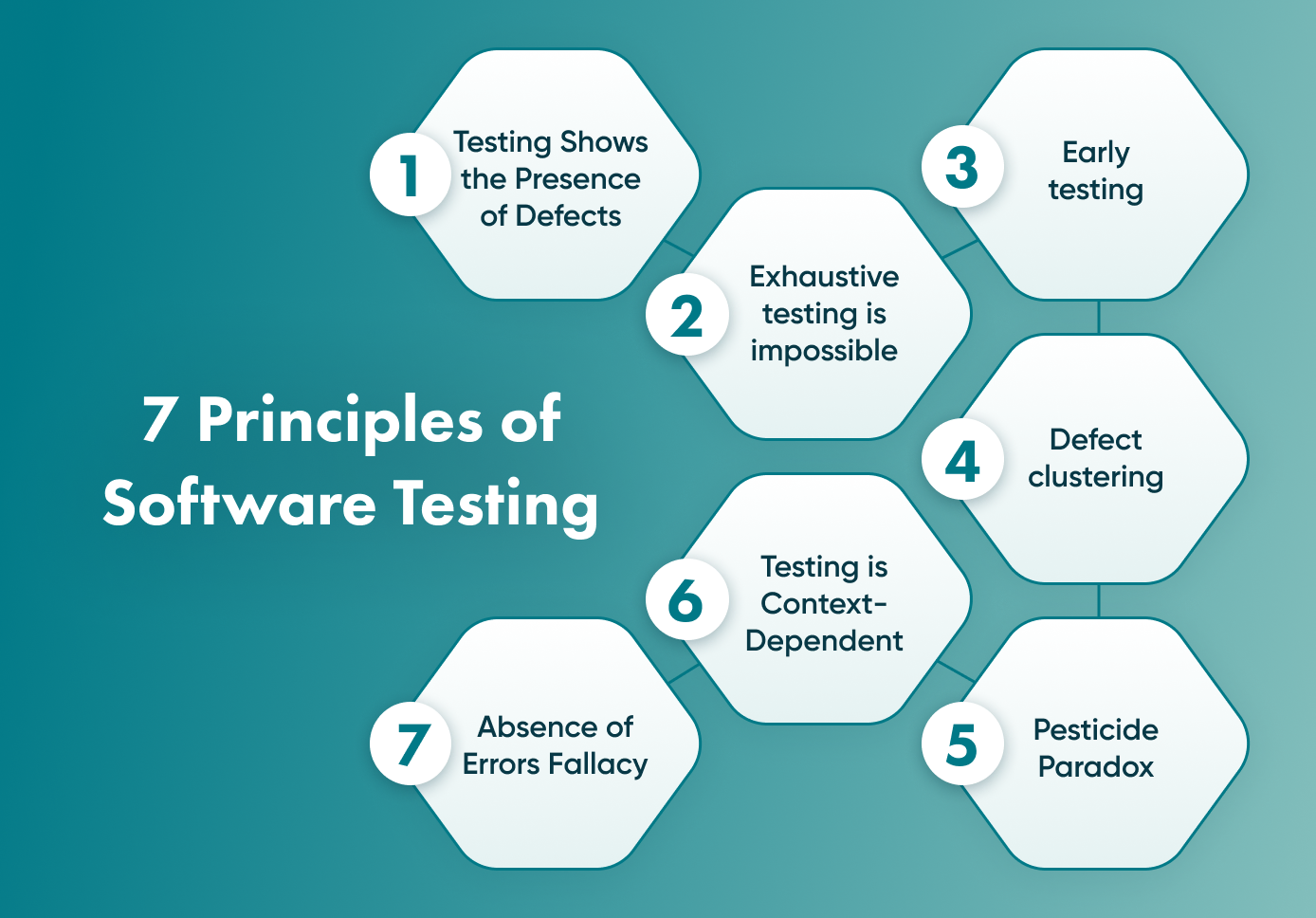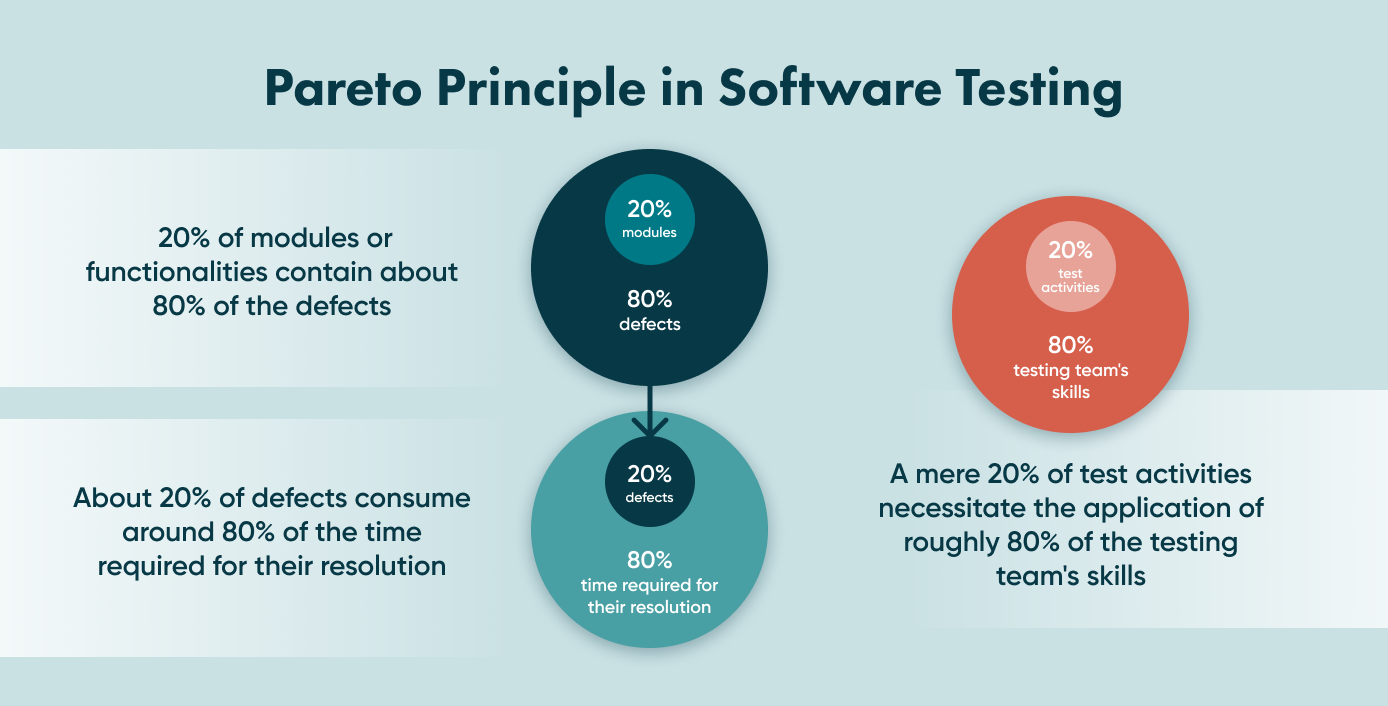The 7 Principles of Software Testing: A Comprehensive Guide


Introduction
In today's technology-driven world, software plays a pivotal role in various aspects of our lives, from communication and entertainment to business and healthcare. As software becomes increasingly integrated into our daily routines, the need for reliable, efficient, and secure software has never been more critical. Software testing serves as a key to ensuring that software meets these high standards. It is the process by which the quality, reliability, and functionality of software applications are assessed.
In this comprehensive guide, we will explore the seven fundamental principles of software testing and their significance in delivering high-quality software solutions. We'll delve deep into each principle, providing real-world examples and actionable insights to help you apply them effectively in your project.

Principle 1: Testing Shows the Presence of Defects
Our journey into the world of software testing begins with the foundational principle that "Testing shows the presence of defects." At first glance, this principle might appear straightforward, emphasising the importance of finding and fixing defects in software. However, it goes beyond mere defect identification, offering valuable lessons about the nature of software quality.
Testing's Purpose
The primary goal of software testing is to identify and reveal defects within a software system. These defects, often referred to as bugs or issues, can manifest in various forms, from incorrect calculations and functional errors to security vulnerabilities and performance bottlenecks. Identifying defects is the first step towards rectifying them and enhancing the software's overall quality. However, it's important to note that testing can only show the presence of defects, not their absence. In other words, no amount of testing can guarantee that a software system is free of errors. This is due to the complexity and dynamic nature of software systems, which make it impossible to test every possible scenario and configuration.
Uncovering Defects Early
While the principle highlights the significance of discovering defects, it also emphasises the importance of doing so early in the software development process. Why is early defect detection crucial? The answer lies in the substantial impact that defects found later in the development cycle can have on both time and cost. Therefore, it's essential for software developers to understand the limitations of testing and to adopt a comprehensive testing strategy that includes various testing techniques such as unit testing, integration testing, system testing, and acceptance testing. This will help to increase the likelihood of uncovering defects and ensuring the software's quality and reliability.
In essence, the principle of "Testing shows the presence of defects" highlights the importance of testing in the software development process and underscores the need for a well-designed testing strategy. It serves as a reminder that testing is not a guarantee of defect-free software, but it is a valuable tool for identifying and fixing defects to improve the quality of the software system. Contact us today and elevate your software development process!
Principle 2: Exhaustive Testing is Impossible
The second principle, "Exhaustive testing is impossible," challenges the notion that comprehensive testing, which involves testing every possible combination of inputs and conditions within a software system, can be achieved. In theory, this approach may seem like the ultimate way to ensure software quality by testing every scenario thoroughly. However, in practice, it is unfeasible.
The Challenge of Comprehensive Testing
Consider a software application with numerous input variables and parameters. Testing every conceivable combination of these variables would require an impractical amount of time and resources. For instance, a simple login system with only two input fields (username and password) already presents numerous potential combinations. In reality, software systems are far more complex, with hundreds or thousands of variables and input possibilities.
Introducing Risk-Based Testing Technique
To address the impracticality of exhaustive testing, software testing practices have evolved to embrace risk-based testing. This approach involves identifying and prioritising test cases based on their potential impact on the software's functionality and reliability.
Instead of attempting to test every possible combination, testers focus their efforts on scenarios and inputs that are most likely to result in defects or have the greatest impact on users. This targeted approach optimises test coverage, ensuring that critical areas of the software are rigorously tested while acknowledging that some less critical aspects may receive lighter scrutiny. By focusing testing efforts on high-risk areas, organisations can optimise their testing resources and increase the likelihood of uncovering critical defects.
While exhaustive testing may be unattainable, risk-based testing techniques offer a practical and effective alternative for ensuring software quality.
Principle 3: Early Testing
The third principle, "Early testing," underscores the importance of initiating the testing process as early as possible in the software development lifecycle. Early testing offers several compelling advantages, ranging from cost-effectiveness to defect prevention.
Cost-Effective Defect Detection
One of the primary benefits of early testing is its cost-effectiveness. Detecting and addressing defects at an early stage of development is significantly more economical than doing so later in the project. Let's explore why this is the case.
Imagine a scenario where a defect is detected during the final stages of testing or even worse, after the software's release. Correcting such a defect at this stage can lead to extensive rework, potentially affecting multiple components of the software and could lead to delayed release dates, and increased development costs. The longer a defect remains undiscovered, the costlier its resolution becomes. In contrast, when defects are identified early in the development process, they can be addressed promptly and with minimal disruption, saving both time and resources.
Impact on Project Duration
In addition to cost savings, early testing has a positive impact on project duration. By identifying and rectifying defects early on, project teams can maintain a steady development pace without the interruptions and delays associated with late-stage defect discovery.
Principle 4: Defect Clustering
The fourth principle, "Defect clustering," sheds light on a fascinating phenomenon observed in software testing: a small number of modules or functionalities often contain the majority of defects. Understanding and effectively addressing defect clusters is vital for optimising testing efforts.
The Pareto Principle

Defect clustering is closely related to the Pareto Principle, also known as the 80/20 rule, which asserts that roughly 80% of effects result from 20% of causes. In the context of software testing, this principle manifests as follows:
Approximately 20% of modules or functionalities contain about 80% of the defects.
About 20% of defects consume around 80% of the time required for their resolution.
A mere 20% of test activities necessitate the application of roughly 80% of the testing team's skills.
These proportions may not be rigid, but the key takeaway is that defects tend to concentrate in specific areas of the software. This concentration provides a valuable insight into where testing efforts should be concentrated.
Efficient Testing Allocation
Recognizing the presence of defect clusters allows testing teams to allocate their resources more efficiently. Instead of distributing testing efforts evenly across all software components, testers can prioritise the examination of modules or functionalities known to be defect-prone.
For example, consider a complex financial software application. Through historical defect data analysis, the testing team identifies that a particular module responsible for interest rate calculations consistently contains a high number of defects. Armed with this knowledge, the team can devise a targeted testing strategy, allocating more test cases and scrutiny to this specific module.
In summary, the principle of "Defect clustering" urges testing teams to adopt a data-driven approach. By analysing historical defect data and identifying defect-prone areas, teams can optimise testing efforts, enhance software quality, and reduce the likelihood of critical defects slipping through the cracks.
Principle 5: Pesticide Paradox
The Pesticide Paradox, introduced by Boris Beizer, draws an analogy between software testing and pesticide use in agriculture. The paradox explores the concept of the ineffectiveness of relying on the same set of tests over time. Similar to how insects develop resistance to a pesticide when exposed repeatedly, software defects can evade detection if testing practices remain static.

Understanding the Paradox
Imagine a field plagued by various harmful insects. If the same pesticide is applied year after year without variation, some insects will undoubtedly perish. However, others may develop resistance to the pesticide, rendering it ineffective. In some cases, the chosen pesticide might have no effect at all. This analogy forms the basis of the "Pesticide Paradox."
The paradox arises when testing teams continue to use the same set of tests, failing to adapt or diversify their testing techniques. Over time, as the software evolves, the efficacy of these tests diminishes. The tests may uncover fewer defects, and the software could become increasingly susceptible to defects not covered by the static test suite.
Diversification of Testing
To avoid falling victim to the "Pesticide Paradox," testing teams must continually evolve and diversify their testing strategies. This involves periodically reviewing and updating test cases, introducing new testing techniques, and considering different testing perspectives.
For instance, exploratory testing, usability testing, and security testing can complement traditional functional testing to provide a more comprehensive assessment of the software's quality. By introducing these varied approaches, testing teams can uncover defects that might have eluded traditional testing methods.
Regression Testing
Regression testing, a vital component of software testing, plays a pivotal role in addressing the "Pesticide Paradox." It involves retesting the software to ensure that new changes or features do not introduce defects or negatively impact existing functionality. Without effective regression testing, the introduction of new code can inadvertently break previously working parts of the software.
To maintain the relevance of regression test suites, testing teams must regularly update them to reflect changes in the software's functionality and requirements. Automated testing tools are often employed to streamline the execution of regression tests, ensuring that they remain up-to-date and effective.
In summary, the "Pesticide Paradox" serves as a reminder that effective testing requires adaptability and diversification. Embracing different testing techniques and regularly reviewing test cases are essential strategies for countering this paradox and uncovering hidden defects.
Principle 6: Testing is Context-Dependent
Software testing is not a one-size-fits-all endeavour. The testing strategies and approaches employed depend on the specific context of the project. This principle acknowledges that testing requirements can vary significantly across different industries and applications.
Contextual Variations in Testing
Different domains have unique testing requirements and priorities. For instance, testing a delivery app demands a different approach compared to testing software for medical equipment. Each context imposes specific testing criteria, including data security, accessibility standards, scalability, and reliability.
As we examine various domains where software development occurs, we gain insights into how bugs can impact each one. Consider the Mars Climate Orbiter incident, where the incorrect use of imperial units instead of the metric system led to a miscalculation of the spacecraft's trajectory, resulting in its incineration in the Martian atmosphere. Similarly, a computer program that erroneously treated live trades as part of a test environment caused Knight Capital to incur a staggering loss of $460 million.
Perhaps the most tragic example is the Therac-25 error, a machine designed for radiation therapy in cancer treatment. Flaws in the codebase, along with the absence of safety features, resulted in radiation overdoses, leading to three fatalities.
These real-world instances underscore the critical importance of analysing the domain context when formulating a testing strategy and plan for software development. Such an analysis helps identify potential risks and priority areas within the program that demand special attention.
Prioritising Contextual Relevance
To ensure effective testing, organisations must tailor their testing strategies to suit the specific context of each project. Understanding the unique challenges and requirements of a particular domain is crucial for delivering software that not only meets industry standards but also exceeds user expectations.
For example, when testing an e-commerce project, it becomes imperative to consider that software within this domain must strictly adhere to data security protocols and customer identification rules. It should also be designed to comply with accessibility standards to cater to multilingual markets and diverse business regions. Additionally, the software must be prepared for scalability and reliability to handle the demands of a growing customer base.
On the other hand, a program within the banking domain should seamlessly integrate with other critical systems, including utility services and trading platforms. It should provide support for various payment systems such as VISA, AMEX, and MasterCard. Furthermore, it must be versatile enough to serve multiple service sectors, including loans and retail banking services. However, the paramount feature of any banking software should be an error-free mechanism for managing emergencies and addressing mistakes swiftly.
Therefore, when a development team conducts a thorough analysis of the domain context for a software project and utilises the insights gained to formulate a robust testing strategy, the result is a higher-quality product that aligns perfectly with the unique demands of its intended domain. Contact Go Wombat today for a tailored testing strategy.
Principle 7: Absence of Errors Fallacy
The final principle often referred to as the "absence of errors fallacy," indicates that the mere absence of errors does not guarantee the absence of defects in a software system or ensure its flawless operation. This principle highlights the critical importance of actively testing for defects within the software system to identify those that may not surface during initial testing phases.
For instance, the software may undergo rigorous testing, during which any identified issues are promptly reported and resolved. The software appears to align seamlessly with the specified requirements, free from bugs or glitches. However, it can still face challenges during acceptance testing or in the commercial market. This can occur when the software, despite its flawlessness, does not meet the expectations of the end users or proves to be overly complex for their needs.

The Fallacy of Error Absence
One significant reason why the absence of errors cannot be equated with software quality is the impracticality of testing every conceivable combination of inputs and pre-conditions. Consequently, there may exist undetected defects or errors that only manifest during real-world usage, leading to unexpected behaviour or system failures.
Software systems are complex, and the interactions between various components can lead to unexpected behaviours and defects. While initial testing may reveal many defects, it is impossible to anticipate and test every possible scenario and combination of inputs.
Comprehensive Testing for Reliability
The lack of errors may result from insufficient or incomplete testing efforts. Defects or errors within the software can go unnoticed if the testing process does not comprehensively cover various scenarios or lacks adequate test inputs.
In essence, the "absence of errors fallacy" principle serves as a poignant reminder that the absence of reported errors does not imply a defect-free software system or assure its intended performance. To maintain the quality and reliability of a software system, rigorous and thorough testing is imperative to identify and address faults and defects that may manifest in real-world usage scenarios.
Unlock Success with Premium Software Development
Contact us


Conclusion
Incorporating the seven principles of software testing into your software development practices is essential for delivering high-quality software products. These principles serve as guiding pillars, emphasising the importance of early defect detection, risk-based testing, defect clustering awareness, test diversification, context-dependent testing strategies, and the need for comprehensive testing.
By adopting these principles, organisations can enhance software quality, reduce development costs, and ensure user satisfaction. Effective software testing is not merely a phase in the development process; it is a continuous commitment to delivering reliable and defect-free software to meet the evolving needs of users and stakeholders.
Are you ready to implement these principles and elevate your software development process to the next level? Go Wombat is here to help. Contact us today to discuss how our expertise in software testing can benefit your organisation. Together, we'll ensure that your software solutions meet the highest quality standards and exceed user expectations.
How can we help you ?






